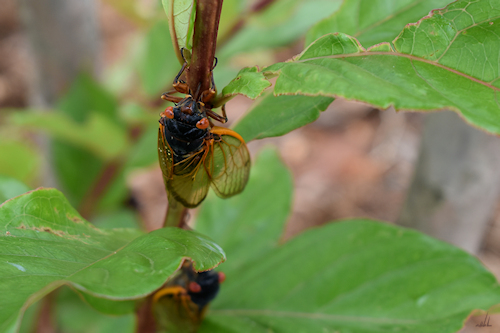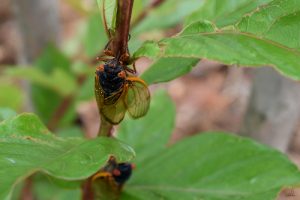
Sap Sucking Cicadas

As we listen to, look at and dodge flying Cicadas I have learned more than I wanted to know about these bugs.
I mentioned in last week’s blog that here in northern Alabama (USA) we are experiencing the presence of the Periodical Cicadas that emerge from underground once every 13 years. The cicadas that have emerged here belong to the Brood XIX. Some of the X Broods emerge once every 17 years and a few areas in the United States will see both the 13 year and the 17 year cicadas emerging during the same time period.
Did you know that true “bugs” do not “eat” their food? That’s one of the fascinating things I have learned when researching these insects. Cicadas are one of those true bugs because they have mouth parts that cannot chew but rather they suck sap out of plants.
Cicadas have beaks called rostrums that are straw shaped. The rostrum pierces the bark of tree branches and then sucks the sap out of the inside of the tree. This gives the cicadas both the nourishment and water necessary to sustain their short adult lives.
Today’s featured image is a photograph looking down on the head of a cicada with its beak stuck in a small branch and sucking sap out of the tree.
Note how transparent the wings are. I also learned that those wings are waterproof!
I have photographs of several cicadas lined up along a single branch, all of them having a meal of tree sap. This was an everyday occurrence for over a week on every branch of a nearby Crepe Myrtle tree. Other male cicadas rested on leaves and small twigs throughout that tree, singing to attract females in order to mate.
For several weeks there has been a constant buzzing/humming/motor sound from those insects. This week we are still hearing their noises but we are seeing fewer cicadas eating and more of them dead on the ground. I suspect that in a few more weeks the evasion of Brood XIX Cicadas will be a thing of the past for another 13 years.
Here are a few more facts I learned about these interesting creatures:
-Cicadas emerge from underground when the soil reaches approximately 64 degrees Fahrenheit at a depth of 12-18 inches.
-It takes a newly emerged cicada about 30 minutes after molting for its new shell-like covering to harden and to pump blood into its wings.
-The male cicadas are the noisiest. They “sing” to attract the females.
-Females cut slits in tree branches and lay their eggs there. They will lay sometimes over 600 eggs, but not all in the same place.
-Cicada eggs hatch six weeks after being laid and eat their way out of the branches and fall to the ground. The cicada nymphs burrow themselves into the soil and feed on the roots of trees and shrubs for the next 13-17 years.
-Adult cicadas live for a short time after emerging from underground, usually only a few weeks.
Please share your thoughts or any experiences with emerging cicadas in the comment section below.
Click here to view a larger version of today’s featured image. Enlarge the photograph to get a better view of the rostrum.
